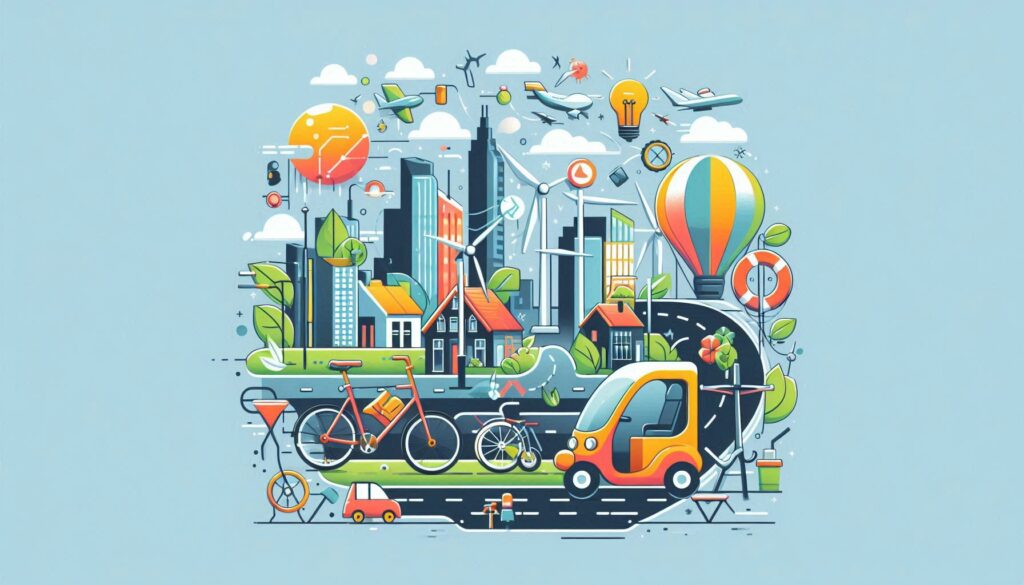Sustainable Living Guide: Eco-Friendly Tips from Vibrant Fitness

Welcome to Sustainable Living with Vibrant Fitness!
Living sustainably means making choices that are good for the environment and for future generations. It’s about using resources wisely, reducing waste, and making eco-friendly choices in our daily lives. This guide from Vibrant Fitness will help you understand the basics of sustainable living and give you practical tips to make your lifestyle greener.
Key Takeaways
- Reduce Your Environmental Impact: Sustainable living involves making daily choices that lessen your impact on the environment.
- Save Money and Help the Planet: Using energy-efficient appliances can save you money while benefiting the planet.
- Reduce Carbon Emissions: Opt for public transportation, cycling, or walking to cut down on carbon emissions.
- Support Local Farmers: Eating locally grown food supports local farmers and reduces your carbon footprint.
- Cut Down on Waste: Recycling and composting are simple ways to reduce waste at home.
Understanding Sustainable Living
Welcome to the world of sustainable living! This lifestyle puts the planet first, both now and for future generations. The goal? To shrink your ecological footprint and promote responsible consumption. Let’s dive into the core principles of sustainable living and why it’s crucial.

Making Your Home More Eco-Friendly
Energy-Efficient Appliances and Fixtures
Ready to make your home a green haven? Start by swapping out old appliances for energy-efficient ones from Vibrant Fitness. Appliances with the Energy Star label use less electricity and can save you money over time. Don’t forget to switch to LED light bulbs—they last longer and use less power. It’s a win-win for your wallet and the environment!
Sustainable Home Renovations
Thinking about a home makeover? Choose eco-friendly materials like bamboo flooring or recycled glass countertops. These choices look fantastic and help the planet. When painting, opt for non-toxic paints to keep your indoor air clean. For those interested, consider installing solar panels to harness renewable energy from the sun.
Eco-Friendly Cleaning Products
Cleaning doesn’t have to be a dirty business! Choose eco-friendly cleaning products that are free from harsh chemicals. Look for labels that say “biodegradable” or “non-toxic.” You can even make your own cleaners using simple ingredients like vinegar and baking soda. Your home will be sparkling clean and planet-friendly.
Making small changes in your home can lead to big benefits for the environment. Plus, you’ll feel great knowing you’re doing your part to help the Earth.
Adopting Sustainable Transportation Methods

Benefits of Public Transportation
Using public transportation is a great way to reduce your carbon footprint. Buses, trains, and subways can carry many people at once, which means fewer cars on the road and less pollution. Plus, you can relax, read, or even nap while someone else does the driving!
Cycling and Walking as Green Alternatives
Cycling and walking are not only good for the environment but also for your health. These modes of travel are eco-friendly and help you stay fit. Imagine getting your daily exercise while commuting to work or running errands. It’s a win-win!
Electric and Hybrid Vehicles
If you need a car, consider an electric or hybrid vehicle. These cars use less fuel and produce fewer emissions compared to traditional gas-powered cars. Switching to an electric vehicle can significantly reduce your carbon footprint. Plus, you’ll save money on gas and maintenance in the long run.
Making small changes in your transportation choices can have a big impact on the environment. Choose wisely and drive green!
Sustainable Food Choices for a Greener Diet
Eating Seasonal and Local Produce
Making green choices in your diet can be as simple as eating what’s in season and grown nearby. This not only supports local farmers but also reduces the carbon footprint from transportation. Plus, seasonal produce is often fresher and tastier!
Reducing Food Waste
Did you know that a significant portion of food ends up in the trash? By planning your meals and using leftovers creatively, you can cut down on waste. Every bit of food saved helps the planet and your wallet.
Plant-Based Diets and Their Impact
Switching to a plant-based diet, even part-time, can have a huge impact on the environment. Plants require fewer resources to grow compared to meat. So, next time you think about dinner, consider a delicious veggie option. Your body and the Earth will thank you.
Small changes in your diet can lead to big changes in the environment. Embrace these green choices and enjoy a healthier, happier life.
Eco-Friendly Fashion and Personal Care

Choosing Sustainable Clothing Brands
When it comes to fashion, you can look good and feel good by choosing sustainable clothing brands. These brands focus on using eco-friendly materials and ethical production methods. Every small action counts in reducing your carbon footprint, so why not start with your wardrobe?
The Importance of Ethical Beauty Products
Taking care of yourself and the planet is easier with ethical beauty products. Opt for natural skincare options, organic soaps, and cruelty-free cosmetics. These products prioritize ingredients sourced sustainably and packaging that minimizes waste, ensuring you can pamper yourself guilt-free.
DIY and Upcycled Fashion Ideas
Get creative and embrace the eco-friendly lifestyle by upcycling old clothes or making your own fashion items. Not only is this a fun way to express your style, but it also helps reduce waste. Try turning an old t-shirt into a trendy tote bag or adding patches to jeans for a fresh look.
Embracing eco-friendly living is a powerful choice that benefits both our planet and our well-being.
Reducing Waste and Embracing Recycling

The Zero-Waste Lifestyle
Ready to dive into the zero-waste lifestyle? Start by embracing the mantra of reduce, reuse, recycle. Begin by cutting down on what you buy, finding new uses for old items, and recycling the rest. A quick look at your daily trash can show you where to improve.
Setting Up a Compost Bin
Setting up a compost bin for kitchen scraps can help you cut down on landfill waste and create nutrient-rich soil for your garden.
Effective Recycling Practices
Recycling can be a bit tricky, but with some expert tips, you can make a big difference. First, get to know your local recycling rules. Not everything can go in the same bin! Separate your recyclables correctly to avoid contamination.
- Paper: Newspapers, magazines, and cardboard
- Plastics: Bottles, containers, and jugs
- Metals: Cans, foil, and tins
- Glass: Bottles and jars
Composting at Home
Composting is a fantastic way to turn your kitchen waste into garden gold. Set up a compost bin in your backyard or even under your sink. Toss in fruit peels, veggie scraps, and coffee grounds. Avoid meat and dairy to keep things from getting smelly.
Composting not only reduces waste but also gives you rich soil to help your plants grow strong and healthy.
Supporting Sustainable Practices in Your Community

Participating in Local Environmental Initiatives
Establishing eco-friendly living practices extends beyond individual actions like installing solar panels and recycling household waste; it involves building a sustainable community. Engage with local environmental organizations, participate in community clean-up events, and support initiatives that promote environmental awareness. Educate yourself and others about the importance of eco-friendly living, sharing tips and resources to inspire collective action towards a greener future.
Advocating for Green Policies
Want to make a bigger impact? Advocate for green policies in your community. Attend town hall meetings, write to your local representatives, and support legislation that promotes sustainability. Your voice matters and can help shape a greener future for everyone. Remember, every small step counts when it comes to creating a healthy work environment.
Building a Community Garden
Imagine a place where neighbors come together to grow fresh, organic produce. Building a community garden is a fantastic way to promote sustainable living while fostering a sense of community. Not only does it provide fresh food, but it also reduces the carbon footprint associated with transporting produce from far away. Plus, it’s a fun way to get your hands dirty and learn about gardening!
Want to make a difference in your community? Start by supporting sustainable practices! From recycling to conserving water, every small action counts. Visit our website to learn more about how you can contribute to a greener future.
Conclusion
Living sustainably is a journey that starts with small, everyday choices. By making eco-friendly decisions, we can all contribute to a healthier planet. Whether it’s reducing waste, choosing sustainable products, or conserving energy, every action counts. Remember, the goal is progress, not perfection. Let’s continue to learn and grow, making our world a better place for future generations. Together, we can make a big difference.
Frequently Asked Questions

What does sustainable living mean?
Sustainable living is about making choices that reduce our impact on the environment. It involves using resources wisely, minimizing waste, and making eco-friendly decisions in our daily lives.
Why is sustainable living important?
Sustainable living is crucial because it helps protect our planet for future generations. By making eco-friendly choices, we can reduce pollution, conserve resources, and combat climate change.
How can I make my home more eco-friendly?
You can make your home more eco-friendly by using energy-efficient appliances, choosing sustainable materials for renovations, and using eco-friendly cleaning products.
What are some sustainable transportation options?
Sustainable transportation options include using public transportation, cycling, walking, and driving electric or hybrid vehicles. These methods reduce carbon emissions and help protect the environment.
How can I reduce waste in my daily life?
To reduce waste, you can adopt a zero-waste lifestyle, practice effective recycling, and start composting at home. These actions help minimize the amount of trash that ends up in landfills.
What are the benefits of a plant-based diet?
A plant-based diet can reduce your carbon footprint, conserve water, and decrease the demand for animal products. It’s also beneficial for your health, providing essential nutrients and reducing the risk of certain diseases.






